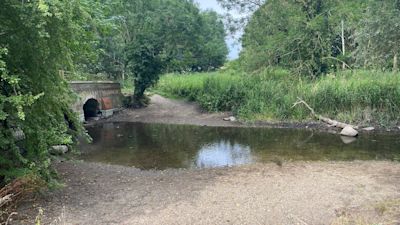Wildlife 'suffering' due to 'exceptionally low' East Anglian river levels, campaigners warn

Video report by ITV News Anglia's Raveena Ghattaura
Campaigners have warned that some rivers have reached "exceptionally low" levels as East Anglia continues to experience one of its driest periods on record.
The first half of this year has only seen two thirds of the normal rainfall in the region - making it the driest six-month period for more than a quarter of a century.
That has led to sections of some rivers drying out, including the River Waveney which is currently only running at 30% of its normal flow.
The Environment Agency has now classified the flow rate in the Waveney as 'exceptionally low', while other rivers like the River Great Ouse at Ely, the River Yare in Norfolk and the Little Ouse in Thetford have all been classed as 'notably low'.
Residents have also noticed a big drop in the water levels of The Black Bourn in Ixworth near Bury St Edmunds.
Speaking to ITV News Anglia, local campaigner Roger Spiller said that he had never seen the river level so low in the three years he has lived in the village.
"It does get low sometimes in the summer and spring, but this is exceptional," he said.
"It was a healthy river at one point, but over the decades, if not the centuries, it has deteriorated.
"More use has been made of the water. The heat we have now means that farmers are using more water to irrigate their crops, and that's one of the big problems we have got.
"Secondly, global warming has changed the climate. Our wildlife, our trees, and our plants are all suffering from water stress."
With no considerable rain in the weather forecast, and the Met Office having now issued an amber extreme heat warning for the early part of next week, there are concerns that the problem could yet get even worse.
Other factors like a growing population and over abstraction of water have also been blamed for contributing to the alarming reduction in levels in some rivers.
In a bid to prevent rivers drying out further, Anglian Water has now capped the amount of water that they are able to take.
Analysis - ITV News Anglia Weather Presenter Aisling Creevey
How worried should we be?
How worried should we be?
The East Anglia rainfall total for the first half of the year was 185mm, or 67% of average.
This number may not seem exceptional on its own, as it could just be that is was an unusually dry first half to the year.
However, the first six months of this year is the driest January to June period since 1996, and the 11th driest such period since records began in East Anglia in 1836.
We have known for a long time now, with certainty, that our climate is warming at an accelerated rate and that there is excessive pressure on our natural resources.
Historically, in a dry year, our natural resources would not have suffered as much because dry years were more unusual. This is no longer the case.
With the increase in extreme weather events, such as long dry spells of weather and excessive heat, something will have to change about how we are living and what we are putting into our environment. This is not surprising.
Advanced computer climate models have been telling us for a long time that the remarkable will soon become unremarkable, and we need all of society to take action to make better decisions about how we live...
"We work really closely with the Environment Agency on the amount of water we are allowed to take out of rivers so that it doesn't damage the environment," Regan Harris, Anglian Water's Media Team Manager, said.
"If we look at areas around Thetford for example, we are taking 20% less out of the river than we would have done previously, and that basically equates to 2,000 million litres a year.
"That is a lot of water less than we would normally take and we will actually be reducing our overall abstraction by 84 million litres over the coming years. So, we take this responsibility really, really seriously."
Want a quick and expert briefing on the biggest news stories? Listen to our latest podcasts to find out What You Need To Know